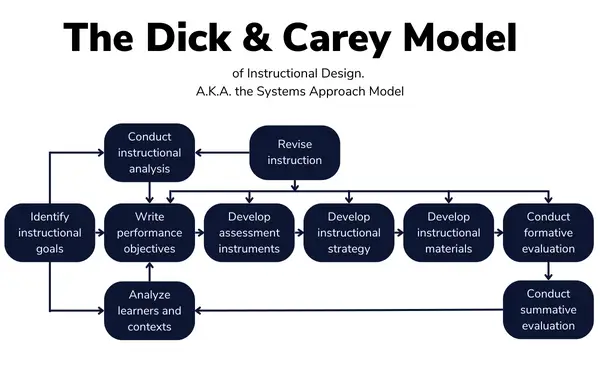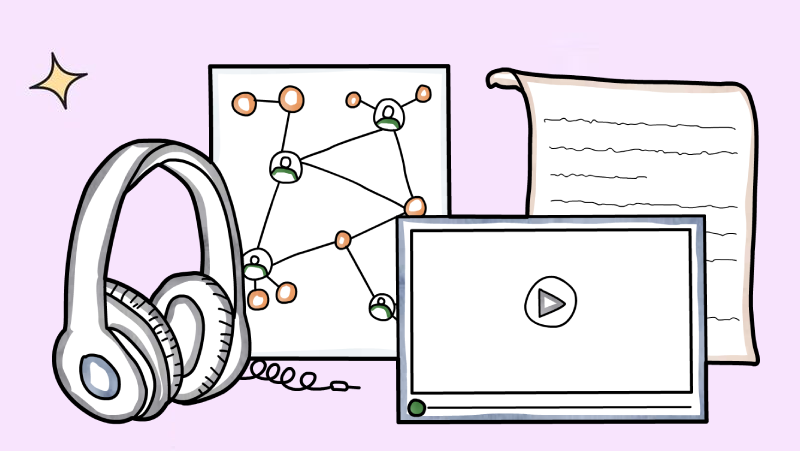Dick and Carey Model
The Dick and Carey Model is a systematic instructional design approach that links every step—from setting goals to evaluating results—into a precise process focused on measurable learning outcomes.

Dick and Carey Model
Overview
The Dick and Carey Model is a systematic approach to instructional design that treats teaching and learning as interconnected systems. Unlike more general frameworks, it breaks the process into highly specific steps that ensure instruction is directly tied to measurable goals and learner outcomes. The strength of the model is its precision: every step builds on the previous one, creating a clear chain from identifying goals to evaluating results. Here's a breakdown of each step:

1. Identify Instructional Goals:
This is the starting point where you define what learners should be able to do by the end of instruction. Goals are expressed in terms of performance, not just knowledge. For example, instead of saying "understand phishing" a proper instructional goal would be "Learners will identify and avoid phishing emails in real-world contexts". This step sets the target for all the work that follows.
2. Conduct Instructional Analysis
Here, the big instructional goal is broken down into smaller, teachable components. Designers map out the knowledge, skills, and procedures learners must master to achieve the goal. For instance, to recognize phishing, learners would need to (1) analyze email structure, (2) identify suspicious links, and (3) know how to verify a sender. The analysis creates a roadmap of prerequisite skills and sub-skills.
3. Analyze Learners and Contexts
This step focuses on who the learners are and the settings in which learning and performance will occur. It includes examining entry behaviors, prior knowledge, attitudes, motivation, and demographic factors. It also considers the learning environment (online, classroom, blended) and the context where learners will apply their new skills. This ensures instruction is realistic and relevant.
4. Write Performance Objectives
Performance objectives are written statements that describe exactly what learners should be able to do after instruction, under what conditions, and how well. These objectives are often based on Bloom's Taxonomy and follow the format of condition, behavior, and criterion. For example: "Given a sample email, learners will correctly identify at least three signs of phishing with 90% accuracy".
5. Develop Assessment Instruments
Assessments are created to measure whether learners meet the performance objectives. Both formative and summative assessments are considered. Continuing with the phishing example, an assessment might provide real or simulated emails for learners to evaluate, ensuring the test reflects authentic performance, not just recall of facts.
6. Develop Instructional Strategy
This step outlines how the instruction will be delivered, including sequencing, activities, feedback, and motivational strategies. The plan must be tied directly to the performance objectives. For phishing, a strategy might include worked examples, guided practice identifying suspicious emails, and gradually more complex scenarios with immediate feedback.
7. Develop and Select Instructional Materials
Here, the actual learning resources are created or adapted. This includes lesson content, visuals, videos, interactive activities, and instructor guides. Materials must align with the instructional strategy and performance objectives. At this stage, prototypes and drafts are tested for clarity and effectiveness before full rollout.
8. Design and Conduct Formative Evaluation
Formative evaluation is carried out during development to test the instruction with 1:1 evaluations or a small groups of learners. Feedback is gathered to identify confusing instructions, unclear content, or technical issues. For example, if learners consistently misinterpret a phishing example, the material can be revised before wide implementation.
9. Revise Instruction
Based on formative evaluation, revisions are made to improve instruction. This step highlights the model's iterative nature—feedback leads directly to changes in content, strategy, or assessments to ensure the final version is effective.
10. Design and Conduct Summative Evaluation
The final step is summative evaluation, which examines the overall effectiveness of the instruction after implementation. It looks at learner achievement, transfer of skills, and impact in the real context. Summative evaluation might ask: Did learners actually apply phishing-avoidance strategies in their workplace? Did the training reduce security incidents? This step validates whether the instruction met its goals.
The Dick and Carey Model is thorough and structured, ensuring no part of instructional design is left to chance. By moving from broad goals to detailed objectives, aligning assessments with real-world performance, and building in evaluation and revision, the model makes instructional design a precise and evidence-driven process.
“The Dick and Carey Model turns instructional design into a systematic chain of connected steps, ensuring that goals, assessments, strategies, and materials work together to produce measurable learning outcomes.”
Identify Instructional Goals
Focus: Define the target
Establish what learners should be able to do by the end of instruction in performance terms.
Conduct Instructional Analysis
Focus: Break down the goal
Deconstruct the main goal into smaller skills, knowledge, and procedures learners must master.
Analyze Learners and Contexts
Focus: Understand who and where
Examine learner characteristics (knowledge, motivation, demographics) and the context where learning and performance will occur.
Write Performance Objectives
Focus: Clarify expectations
Create measurable objectives describing what learners will do, under what conditions, and how well.
Develop Assessment Instruments
Focus: Align tests to objectives
Build assessments (formative and summative) that measure whether objectives are achieved through authentic performance tasks.
Develop Instructional Strategy
Focus: Plan the learning path
Decide on methods, sequence, activities, and feedback approaches that align with objectives.
Develop/Select Instructional Materials
Focus: Create or adapt content
Produce the actual lessons, activities, and media that support the instructional strategy.
Design and Conduct Formative Evaluation
Focus: Test in progress
Pilot-test materials with small groups to identify issues and gather feedback.
Revise Instruction
Focus: Improve based on feedback
Make necessary changes to content, strategy, or assessments to strengthen effectiveness.
Design and Conduct Summative Evaluation
Focus: Validate outcomes
Evaluate the instruction after implementation to measure effectiveness, transfer of skills, and overall impact.

Implications of the Dick and Carey Model for Instructional Design
The Dick and Carey model has important implications for how instructional design is practiced because it treats learning as a system in which all parts must work together. By breaking the process into detailed steps, it ensures that instruction is purposeful, measurable, and closely aligned with learner performance outcomes.
1. Alignment Between Goals, Instruction, and Assessment
One major implication is the emphasis on alignment. Because the model requires performance objectives to be directly connected to assessments and instructional strategies, it prevents common mismatches where learners are taught one thing but tested on another. This systematic connection increases both fairness and effectiveness in learning.
2. Precision in Defining Learning Outcomes
The step of writing performance objectives pushes instructional designers to be specific about what learners should do, under what conditions, and to what standard. This level of detail leads to measurable outcomes and makes evaluation more meaningful. It also elevates the designer's role from content developer to performance engineer.
3. Data-Driven Revision and Continuous Improvement
The built-in stages of formative evaluation and revision imply that instruction is never "finished" after first design. Feedback loops are integral to the process, reinforcing the idea that effective instruction is refined through evidence and learner response rather than assumption.
4. System Thinking in Instructional Design
The model emphasizes interdependence between goals, learner analysis, content, and assessments. This systems perspective means that if one part of the process changes—such as learner needs or organizational context—other parts must adapt too. Instruction is therefore seen as dynamic and responsive rather than static.
5. Accountability and Evidence of Effectiveness
Finally, the inclusion of summative evaluation ensures that instructional design is held accountable not just for delivery, but for actual outcomes. This has broader implications for organizations, as designers can demonstrate return on investment through improved learner performance and measurable organizational results.
“By making every step explicit and connected, the Dick and Carey Model transforms instructional design into a process of alignment, accountability, and continuous improvement.”


